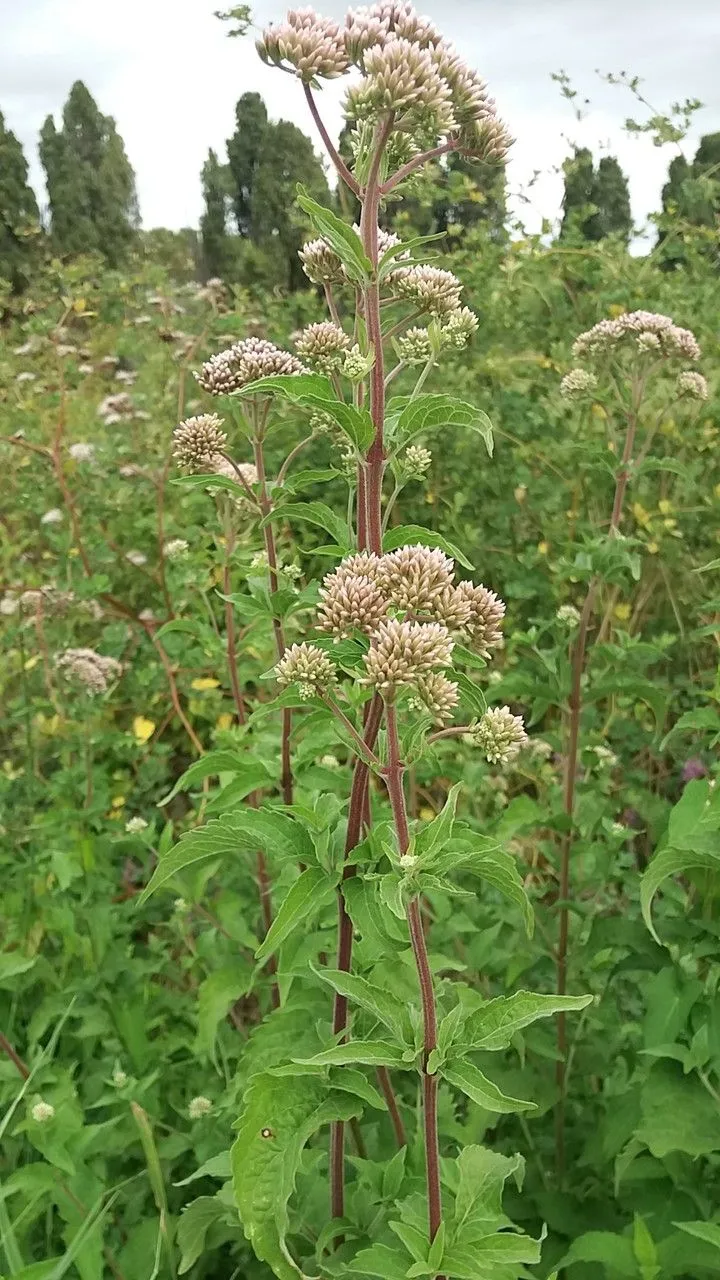
Author: L.
Bibliography: Sp. Pl.: 838 (1753)
Year: 1753
Status: accepted
Rank: species
Genus: Eupatorium
Vegetable: False
Observations: Canada to U.S.A.
Boneset, scientifically known as Eupatorium perfoliatum, is a noteworthy and cherished plant within the Asteraceae family. Recognized and described in 1753, this perennial herb derives its common name from its historical use in traditional medicine, chiefly to heal broken bones and alleviate fevers.
This prolific plant can predominantly be found stretching across a broad range from Canada down to the United States. Boneset thrives in wet, swampy areas and is often spotted in meadows, wetlands, and along the edges of streams and rivers, standing tall amid the lush greenery with a robust, upright structure ranging anywhere between 3 to 4 feet in height.
Boneset is easily identifiable by its distinctive serrated leaves which are perfoliate, meaning the base of each pair of leaves seems to be perforated by the stem. This unique leaf arrangement, along with its coarse texture, makes the plant distinguishable in the wild. Come late summer and early autumn, Boneset produces clusters of small, fluffy white flowers that bloom atop its sturdy stems, offering not only a touch of beauty to its habitat but serving as a vital nectar source for various pollinators, including bees and butterflies.
Historically, Boneset has held an esteemed place in herbal medicine. Native American tribes utilized the plant extensively, brewing the leaves and flowers into teas to treat colds, flu, and fever, asserting its role as both a comforting and healing remedy. The plant’s name, “Boneset,” is derived from its use in treating ‘breakbone fever,’ a term historically associated with severe cases of influenza where fever induced muscle pain so intense, it felt akin to broken bones.
In addition to its fever-reducing properties, Boneset has been used for its purported anti-inflammatory and immune-boosting effects, making it a staple in traditional medicinal practices. Though modern medicine has largely overtaken ancient herbal remedies, Boneset still finds its place in homeopathic treatments and among herbal enthusiasts who prize the plant for its natural healing attributes.
In summary, Eupatorium perfoliatum, or Boneset, remains a significant botanical specimen with a storied past and continuing relevance. From its striking, perforated leaves to its clusters of pollinator-friendly flowers, and its deep roots in traditional healing, this plant embodies both the beauty and utility of nature’s diverse flora.
Eng: boneset, chapman’s thoroughwort, common boneset, thoroughwax, thoroughwort, perfoliate thoroughwort
Deu: durchwachsener wasserdost
Fra: eupatoire perfoliée
Swe: läkeflockel
En: Boneset, Common boneset, Thoroughwax, Thoroughwort, BONSET, Chapman’s thoroughwort, Perfoliate thoroughwort
Fr: Eupatoire perfoliée
De: Durchwachsener Wasserdost
Sv: Läkeflockel
Taken Jul 31, 2021 by John Murtaugh (cc-by-sa)
Taken Aug 29, 2021 by George Annette (cc-by-sa)
Taken Aug 31, 2022 by Richard Wideman (cc-by-sa)
Taken Sep 3, 2021 by Peter Peter Kikic (cc-by-sa)
Taken Aug 5, 2021 by Rob Shave (cc-by-sa)
Taken Aug 29, 2021 by George Annette (cc-by-sa)
Taken Jun 30, 2021 by gail page (cc-by-sa)
Taken Aug 31, 2022 by Richard Wideman (cc-by-sa)
Taken Aug 15, 2021 by Ah Leny (cc-by-sa)
Taken Aug 14, 2021 by Ray Boyd (cc-by-sa)
Taken Jul 4, 2015 by EOL − botany08 (cc-by)
Taken Jul 25, 2015 by EOL − James Mickley (cc-by-nc)
Taken Aug 8, 2015 by EOL − Aarongunnar (cc-by-nc)
Taken Aug 3, 2015 by EOL − Evan Raskin (cc-by-nc)
Taken Sep 14, 2017 by francois tissot (cc-by-sa)
Taken Sep 19, 2013 by EOL − Susan Elliott (cc-by-nc)
Taken Aug 3, 2015 by EOL − Evan Raskin (cc-by-nc)
Taken Aug 3, 2015 by EOL − Evan Raskin (cc-by-nc)
Taken Oct 3, 2019 by grav stacey (cc-by-sa)
Taken Aug 5, 2019 by Mary Pierce (cc-by-sa)
Taken Sep 18, 2015 by EOL − camelcreek (cc-by-nc)
Taken Feb 5, 2014 by EOL − Anita (cc-by-nc)
Taken Aug 1, 2015 by EOL − Matt Rung (cc-by-nc)
Taken Aug 8, 2015 by EOL − botany08 (cc-by)
Taken Oct 16, 2021 by Sonya Charest (cc-by-sa)
Taken Feb 24, 2022 by Villena Rojas Marcelo (cc-by-sa)
Taken Aug 5, 2019 by Mary Pierce (cc-by-sa)
Taken Oct 3, 2019 by grav stacey (cc-by-sa)
Growth habit: Forb/herb
Family: Myrtaceae Author: (F.Muell.) K.D.Hill & L.A.S.Johnson Bibliography: Telopea 6: 402 (1995) Year: 1995 Status:…
Family: Rubiaceae Author: Pierre ex A.Froehner Bibliography: Notizbl. Bot. Gart. Berlin-Dahlem 1: 237 (1897) Year:…
Family: Sapindaceae Author: Koidz. Bibliography: J. Coll. Sci. Imp. Univ. Tokyo 32(1): 38 (1911) Year:…
Family: Asteraceae Author: A.Gray Bibliography: Pacif. Railr. Rep.: 107 (1857) Year: 1857 Status: accepted Rank:…
Family: Fabaceae Author: Medik. Bibliography: Vorles. Churpfälz. Phys.-Ökon. Ges. 2: 398 (1787) Year: 1787 Status:…
Family: Aspleniaceae Author: (Cav.) Alston Bibliography: Bull. Misc. Inform. Kew 1932: 309 (1932) Year: 1932…